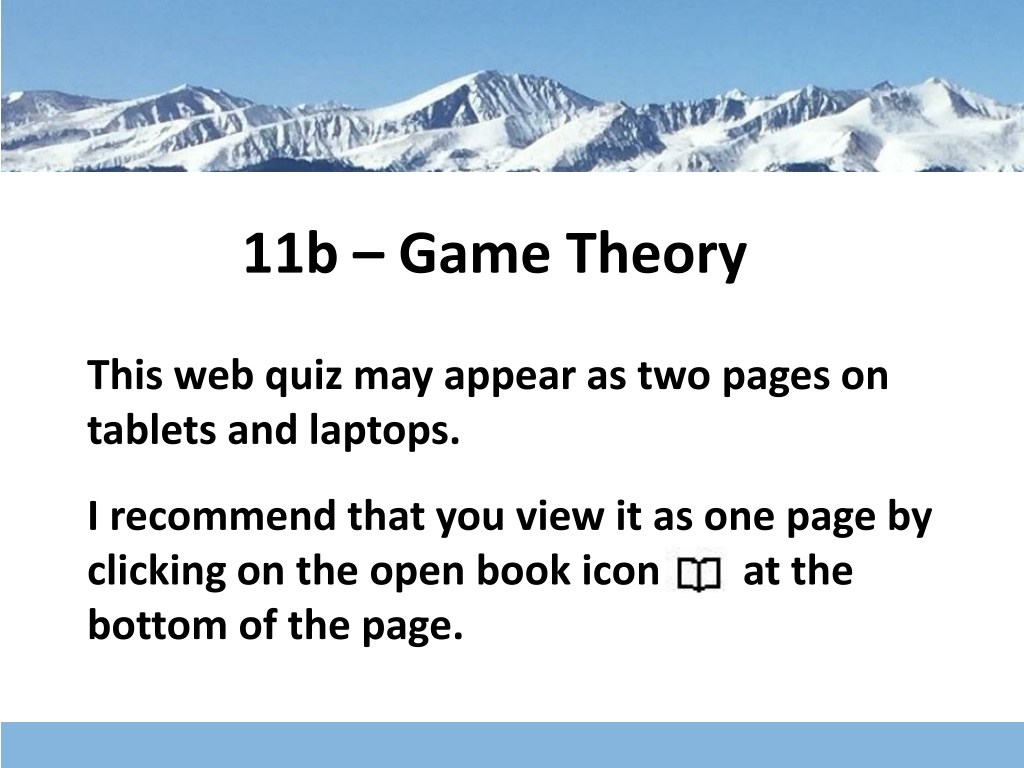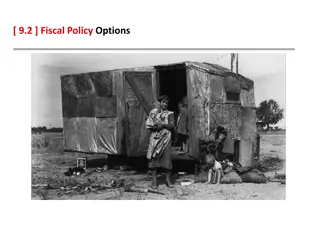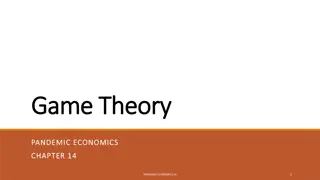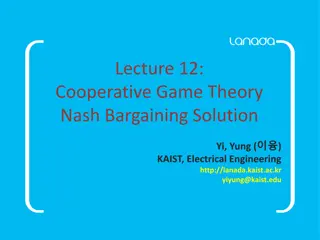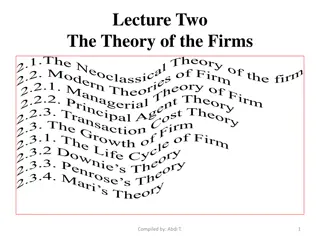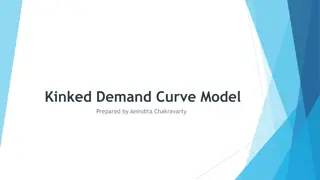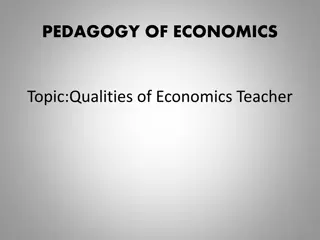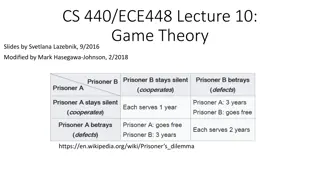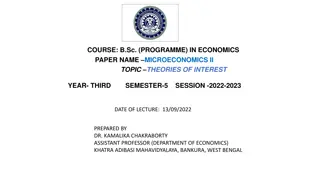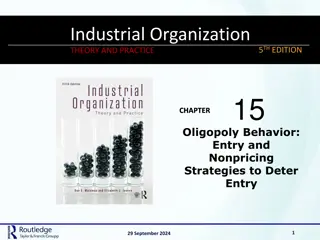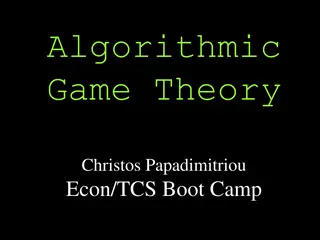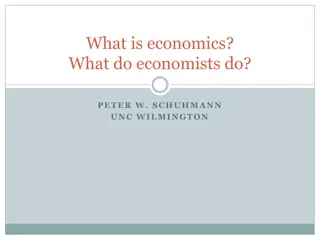Oligopoly and Game Theory in Economics
Explore the concepts of game theory and oligopoly in economics, including strategic behavior, dominant strategy, self-enforcing agreements, Nash equilibrium, and more. Learn how decision-making in oligopolies is influenced by the actions of competitors, and why collusion agreements may be disrupted due to temptation to cheat.
Uploaded on Sep 19, 2024 | 0 Views
Download Presentation

Please find below an Image/Link to download the presentation.
The content on the website is provided AS IS for your information and personal use only. It may not be sold, licensed, or shared on other websites without obtaining consent from the author.If you encounter any issues during the download, it is possible that the publisher has removed the file from their server.
You are allowed to download the files provided on this website for personal or commercial use, subject to the condition that they are used lawfully. All files are the property of their respective owners.
The content on the website is provided AS IS for your information and personal use only. It may not be sold, licensed, or shared on other websites without obtaining consent from the author.
E N D
Presentation Transcript
11b Game Theory This web quiz may appear as two pages on tablets and laptops. I recommend that you view it as one page by clicking on the open book icon at the bottom of the page.
11b Game Theory Must Know / Outcomes: Use a profit-payoffs matrix (game theory) to explain the mutual interdependence of two rival firms and that the best outcome may not be individually rational Use a profit-payoffs matrix (game theory) to explain why oligopolists might tempt to cheat on a collusive agreement. Definitions: Strategic behavior / strategic interaction Prisoner s Dilemma Dominant Strategy Self enforcing agreement Individually rational Nash Equilibrium
11b Oligopoly - Game Theory Definitions: Strategic behavior / strategic interaction: Decision-making when the outcome also depends on the actions of others Prisoner s Dilemma: The best choice for both players is not the equilibrium (rational) outcome Dominant Strategy: a choice for a player that maximizes their satisfaction no matter what their rivals are doing Self enforcing agreement: Occurs when both players cannot improve their situation by changing their choice Individually rational: choice that increases your satisfaction Nash Equilibrium: The outcome (equilibrium) of game theory when each player is individually rational (their dominant strategy) given what all other players are doing
1. Strategic behavior means: 1. outcome depends not just on what you do, but what your competitor does 2. neither can improve their situation by changing their minds 3. a choice for a player that maximizes her satisfaction no matter what her rivals are doing
1. Strategic behavior means: 1. outcome depends not just on what you do, but what your competitor does 2. neither can improve their situation by changing their minds 3. a choice for a player that maximizes her satisfaction no matter what her rivals are doing
2. Dominant Strategy means: 1. outcome depends not just on what you do, but what your competitor does 2. neither can improve their situation by changing their minds 3. a choice for a player that maximizes her satisfaction no matter what her rivals are doing
2. Dominant Strategy means: 1. outcome depends not just on what you do, but what your competitor does 2. neither can improve their situation by changing their minds 3. a choice for a player that maximizes her satisfaction no matter what her rivals are doing
3. Self enforcing agreement means: 1. outcome depends not just on what you do, but what your competitor does 2. neither can improve their situation by changing their minds 3. a choice for a player that maximizes her satisfaction no matter what her rivals are doing
3. Self enforcing agreement means: 1. outcome depends not just on what you do, but what your competitor does 2. neither can improve their situation by changing their minds 3. a choice for a player that maximizes her satisfaction no matter what her rivals are doing
4. What is Nash Equilibrium? 1. outcome depends not just on what you do, but what your competitor does 2. neither can improve their situation by changing their minds 3. the outcome when each player is doing the best they can given what all other players are doing 4. a choice for a player that maximizes her satisfaction no matter what her rivals are doing
4. What is Nash Equilibrium? 1. outcome depends not just on what you do, but what your competitor does 2. neither can improve their situation by changing their minds 3. the outcome when each player is doing the best they can given what all other players are doing 4. a choice for a player that maximizes her satisfaction no matter what her rivals are doing
Nash Equilibrium The outcome when each player is doing the best they can given what all other players are doing PRISONER S DILEMMA: The Nash equilibrium is both of them confessing. The best option for both of them would be to not confess.
For the following questions refer to this game theory matrix where the numerical data show the profits resulting from alternative combinations of advertising strategies for Ajax and Acme. YP 63
5. If company A does a high price then the dominant strategy for B will be: YP 63 1. Low Price 2. High Price 3. Neither
5. If company A does a high price then the dominant strategy for B will be: YP 63 1. Low Price 2. High Price 3. Neither
6. The dominant strategy will be: YP 63 1. High for A; Low for B 2. Low for A; High for B 3. Low Price for both 4. High Price for both
6. The dominant strategy will be: YP 63 1. High for A; Low for B 2. Low for A; High for B 3. Low Price for both 4. High Price for both
7. The Nash equilibrium will be cell: (YP 63) 1. A 2. B 3. C 4. D
7. The Nash equilibrium will be cell: (YP 63) 1. A 2. B 3. C 4. D
DEFINITION: Nash Equilibrium The outcome (equilibrium) of game theory when each player is individually rational (their dominant strategy) given what all other players are doing. A self-enforcing agreement. No one can gain by changing strategies if nobody else does.
Nash Equilibrium is cell A. No one can gain by changing strategies if nobody else does.
8. Without collusion, the outcome of the game is cell: (YP 63) 1. A 2. B 3. C 4. D
8. Without collusion, the outcome of the game is cell: (YP 63) 1. A 2. B 3. C 4. D
9. With collusion and no cheating, the outcome of the game is cell: (YP 63) 1. A 2. B 3. C 4. D
9. With collusion and no cheating, the outcome of the game is cell: (YP 63) 1. A 2. B 3. C 4. D
10. If A and B agree to a high price policy through collusion, the temptation to cheat on that agreement is demonstrated by the fact that: (YP 63) 1. Company A can increase profits by charging a lower price 2. Company A can increase profits by charging a higher price 3. Profits increase if both charge a lower price
10. If A and B agree to a high price policy through collusion, the temptation to cheat on that agreement is demonstrated by the fact that: (YP 63) 1. Company A can increase profits by charging a lower price 2. Company A can increase profits by charging a higher price 3. Profits increase if both charge a lower price
